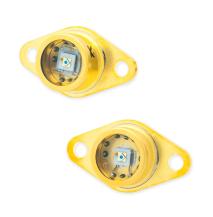A high-performance si APDS can be a desktop computer, laptop, tablet, or smartphone with the best components available. The components include the processor, RAM, graphics card, and hard drive. This type of equipment allows you to do more with your computer, including running more demanding applications.
The components in your computer are referred to as
"hardware" or simply "hard." You might also hear people
refer to specific parts by their manufacturer's name: a Core i7 processor is an
Intel-branded CPU.
There are several different components in a high performance si APDS, and each plays a specific role. In
this section, you'll learn what they are and how they work.
How High-Performance si APDS
Work
High-performance Silicon Avalanche Photodiodes (Si APDs)
have become a popular choice for optical communication systems due to their
high sensitivity in the 1.3 um range. They are used in receivers, as well as
for in-line optical power monitoring and optical tap applications.
The main performance parameters for Si APDs are:
Sensitivity-The
light power required at the detector input to generate a given output signal.
This is typically expressed in mW or dBm at the detector input and in mV or dBm
at the detector output.
Speed – How fast the signal can be
detected and processed, which is often limited by the bandwidth of the
trans-impedance amplifier (TIA) driving the detector. This is typically
expressed in GHz or MHz.
Linearity – How well a signal is reproduced
from input to output. This is typically expressed as a percentage error
(%ERROR) but can also be expressed as a distortion factor (DF).
Benefits
Available in different
configurations
The good thing about high-performance si APDS is that they
are available in many different configurations. This means that you can
customize them according to your specific needs. For example, if you want an
APD that works with a particular type of laser, you can do so. It is also
possible if you want an APD that works with a certain range of wavelengths.
Can operate at high speeds
High-performance si APDS is that they are capable of
operating at high speeds. This means that you will have a device that can
quickly produce large amounts of data. This makes them ideal for use in
applications where speed is important such as in medical imaging systems,
telecommunications, and other fields where speed is crucial. When using these
devices, it's important to note that they must be operated regularly to ensure
proper function.
Ideal for your needs
They'll meet your needs for high-speed, low noise detection,
whether you need simple amplitude measurements or single-photon sensitivity.
Better noise performance
Si APDs have better noise performance than regular
photodiodes because of their lower dark current and higher responsivity from a
photodiode standpoint. From an amplifier point of view, Si APDs are faster than
transistors because they have virtually no parasitic capacitance in the
multiplication region. The bandwidth advantage is greater for low-field devices
than for high-field devices because of the relatively small capacitance at low
fields.
With their high gain and low noise, our Si APDs provide the
best possible signal-to-noise performance when compared to all other
semiconductor photodetectors. The higher the internal gain of an optical
detector, the lower the noise floor, which results in a better signal-to-noise
ratio (SNR). This is particularly important in photon counting applications
where it enables operation at lower photon levels. In terms of bandwidth, some
Si APDs have a response time that is about 100 times faster than a typical Si
PIN diode.
Bottom line
High-performance silicon avalanche photodiodes (Si APDs) are
photoelectric devices that use the impact ionization process to amplify the
signal current. When an electron accelerated by a high electric field collides
with a silicon atom in the impact ionization process, it generates two or more
electrons. These secondary electrons are accelerated and, in turn, collide with
silicon atoms to generate even more electrons. This process continues as long
as there is an electric field present.
The amplification gain of the Si APD is proportional to the
applied reverse bias voltage so that a higher gain can be achieved at higher
electric fields. The gain depends on the doping profile of the Si APD. For
example, a higher carrier concentration in the intrinsic region leads to a
higher multiplication factor.










